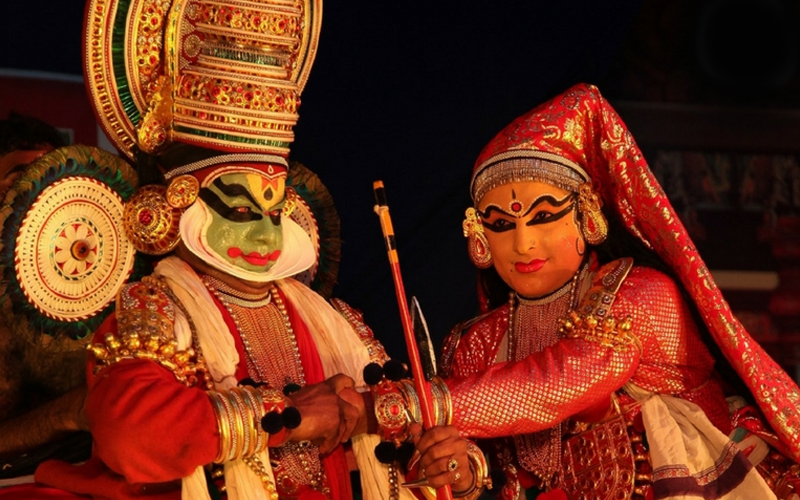
Art Forms of Kerala
The Indian state Kerala is well known for its diverse forms of performing arts. The various communities in Kerala contribute to its rich and colorful culture.
For tourists who search for something other than what’s expected in this staggering area can investigate the Art Forms of Kerala which are extraordinary and commendable. Kerala has an abundance of social practices and a variety of customary works of art than whatever other express that draws in individuals from everywhere the world, offering a gala of craftsmanship, dance and music for vacationers and workmanship darlings.
Most popular traditional art forms of Kerala are Kathakali, Mohiniyattam, Chakyar Koothu, Nangiar Koothu, Theyyam, Panchavadyam, Ottamthullal, Padayani, Onapottan, Pulikali, Krishnanattam, Koodiyattam, Kalaripayattu, Pavakathakali, Thirayattam, Shastham Paatu, Ayyappan Vilakku, Chavittunatakom, Duffmuttu, Kakkarissi Natakam, Margomkali, Oppana, Thiruvathirakali, Arjuna Nritham, Kalamezhuthu, Kavadiyattam, Mudiyettu, Paana, Poothanumthirayum, Theeyattu, Tholppavakkoothu, Velakali, Kannyarkali, Kolkali, Kummattikkali, Garudan Thookkam, Sarpam Thullal, Pulluvan Paattu, Yakshagana, Pettathullal, Mappila Paattu, Parichamuttukali etc.
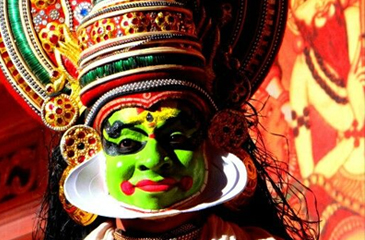
Kathakali
Kathakali is one of the images that first come to mind when thinking about Kerala. The significance and popularity of this legendary dance form are viewed from the vast multitude of tourists and art lovers it continues to mesmerize. Originated around the 17th century, with its roots in Kerala’s traditional temple and folk scene, Kathakali is a storytelling art form performed using intricate facial expressions and hands and feet gestures. With grand costumes, enchanting makeup and verses recited in Sanskritised Malayalam, Kathakali remains a beautiful ode to Kerala’s opulent legacy.
Padayani
Padayani is the annual ritualistic folk art performed in Bhagavati (Goddess Kali) temples of the central Travancore. Padayani, infact, is the equivalent of Malabar’s Theyyam. It is regarded as originating from the ancient Dravidian concept of worshipping God, through Rathi (lust), Raktham (blood) and Lahari (intoxication). A blend of music, dance, painting and satire, Padayani is considered to be the reflection of the ancient socialist society before the Aryanization and Chathruvarnya, the four caste system. The songs sung in simple Malayalam are passed down orally from the ancestors over the years and the main instrument in use is the thappu.

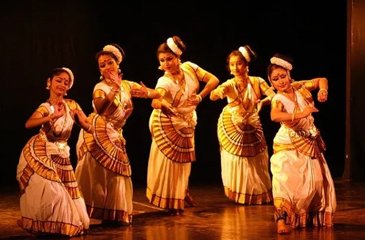
Mohiniyattam
A classical dance originated in Kerala, Mohiniyattam, roughly translated as the ‘Dance of the enchantress, Mohini’ is one of the 8 Classical dances of India recognized by the Sangeet Natak Akademi. Originally the temple dance performed by Devadasis, it portrays feminine love in its myriad forms - carnal, devotional and maternal- with the accent more on Lasya and Bhava. As an art form, Mohiniyattam has a tradition over hundreds of years and is believed to have been originated in the 9th century CE.
According to the Hindu mythology, Mohini is a divine temptress, an embodiment of beauty, femininity and allure. The dance performed is very graceful and feminine. The body movements characterize a fine sway of the torso from side to side, circular swinging body movements to make an eight, and far sweeping steps. The eyes of the dancer play an important role in accenting the direction of the movement. Mohiniyattam overall is characterized by complex foot and bodywork as well as facial expressions.
Chakyar Koothu
A satirical art form, hundreds of years old that used to be performed in temples, Chakyar Koothu shows a completely different angle of South Indian art and its legacy. A solo performance, by a narrator in a distinctive headgear and black moustache with his trousseau smeared with sandalwood paste and red dots all over the body, the performance is reminiscent of the modern stand-up comedy act. The headgear resembles snake’s hood, to symbolize it is narrated by Anantha, the thousand-headed-serpent. The act incorporates commentary on socio-political events, and even includes humorous personal quirks and comments directed at the members of the audience. The narration of the story is based on the Sanskrit style of Champu Prabandha- a mixture of gadya (prose) and shloka (poetry).
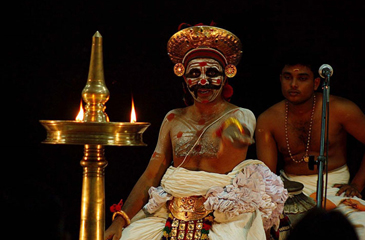
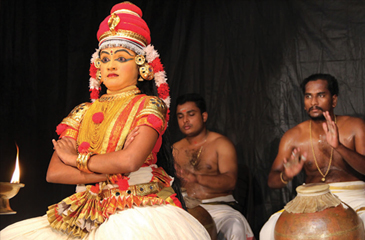
Nangiar Koothu
Presented as a dramatic monologue, traditionally performed by the Nangiars, the womenfolk of the Nambiar community, Nangarkoothu is an art form with an ancestry over 15oo years. The Nangyarkoothu presenter is known as Nangiaramma. Clad in resplendent attire, adorned with exquisite accessories, the danseuse has to transform herself as all the characters, be it a male, female, a supporting character or even a child to act out the story. Through exquisite hand gesture, facial expressions and body movements, she entertains the spectators with satire and humour accompanied by the resonant pot drum Mizhavu.
Ottamthullal
Heralding a rich heritage, Ottamthullal is the most prominent among the many Thullal dance forms of Kerala (others being Seethangan thullal, Parayan thullal, etc.) One of the most interesting dance forms as is evidenced from its literal translation, run (ottam) and jump (thullal), Ottamthullal, just like chakyarkoothu addresses socio-political issues in satire form.
This exhilarating art form is believed to have started by Kalakkath Kunjan Nambiar in the 18th century. Donning green makeup and wearing colourful attires, the solo performer recites the thullal lyrics, all the while dancing and singing by himself. Thullal songs have a fast tempo and are often in the Malayalam language. The dance is more of a jumping and prancing around rather than one involving aesthetic grace. Like in Chakyarkoothu, the performer keeps the audience entertained throughout with quirky and humourous remarks often even aimed at the audience themselves.
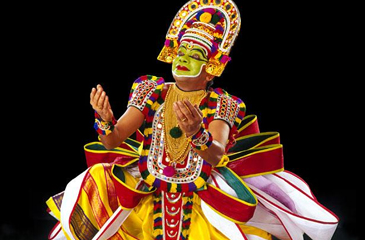
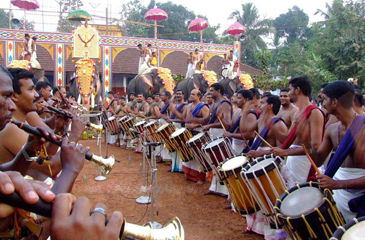
Panchavadyam
Often described as the soul of Kerala, the grand and enchanting orchestral performance of Panchavadyam is a unique experience and a true symphony for the senses. It involves the high pitched rhythmic rendition of classical tunes using 5 indigenous musical instruments, hence, literally translating as the ‘five (pancha) orchestra (vadyam)’. These five musical instruments are kombu, edakka, thimila, ilathalam, and maddalam. The basic rule is to use instruments in the category of thatham, vithatham, ghnanam (non-drum) and sushiram (wind instrument). In Panchavadyam, there exists no limit to the number of performers. This extravagant orchestral performance finds its way extensively in religious festivals, weddings and other celebrations adding a vibrant fervour and a sense of spiritual tranquillity to the occasion.
Oppana
As the vivid wedding dance form of the Muslims of Malabar, Oppana owns a renowned position in the cultural annals of Kerala. The word Oppana is derived from the Arabic word Afna. This colourful dance form is performed by 15 females, around the bride who sits in a chair draped in ceremonial attire, gold ornaments with ornate mehndi adorning her hands and feet. The dancers clap their hands, sway and serenade tunes of Mappilapattu with innuendo leaving the bride blushing. An indispensable component of all Muslim weddings, Oppana is a beautiful reflection of an illustrious and opulent tradition of Kerala.
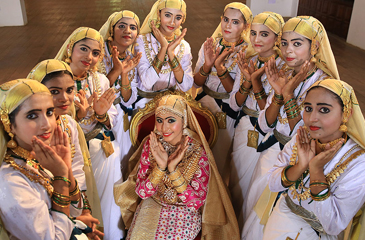

Theyyam
A truly mesmerising ritualistic dance form of the Kolothunadu (Kingdom of Cannanore), Theyyam is called the ‘Dance of Gods’. Often performed from the Malayalam month of Thulam (October/November) until June widely in states Kannur and Kasargod, Theyyam is an enchanting visual poetry unlike any. With its root steeped in the age-old Dravidian culture of South India, Theyyam is a mélange of dance, drama, music and mime. The subjects of these performances are often tales of divine heroes and celestial spirits.
Performers wear heavy make-up, huge masks and flamboyant costumes for dramatic appearance and spectacular presence. Such ornamental make-up and costumes help performers personify the grandeur of mythological figures including gods, goddesses, spirits and demons. Perhaps the most important aspect of this tribal dance form from a wider angle is that the Theyyam performers are actually people belonging from lower castes and who do meagre jobs during other parts of the year. From the time he dons the extravagant costumes and makeup of Theyyam, he becomes a ‘god’ for even the upper class.
There are as much as 400 different forms of Theyyam, each being unique in style, music, choreography, make-up, costumes, etc. The popular ones are Pottan, Kari Chamundi, Gulikan, Vishnumurthy, Nagakanni, Veerali, Raktha Chamundi, Bhagavati, and Mutiappan.

Agada Health
1B, Skyline Belair,
Near Regional Passport office,
Panampilly Nagar, Cochin - 682036
Top Hospitals
Medical Experts
Top Departments
Terms of use | Privacy Policy | Contact us
© 2021 Agada. All Rights Reserved
Designed & Developed by Websoul Techserve





